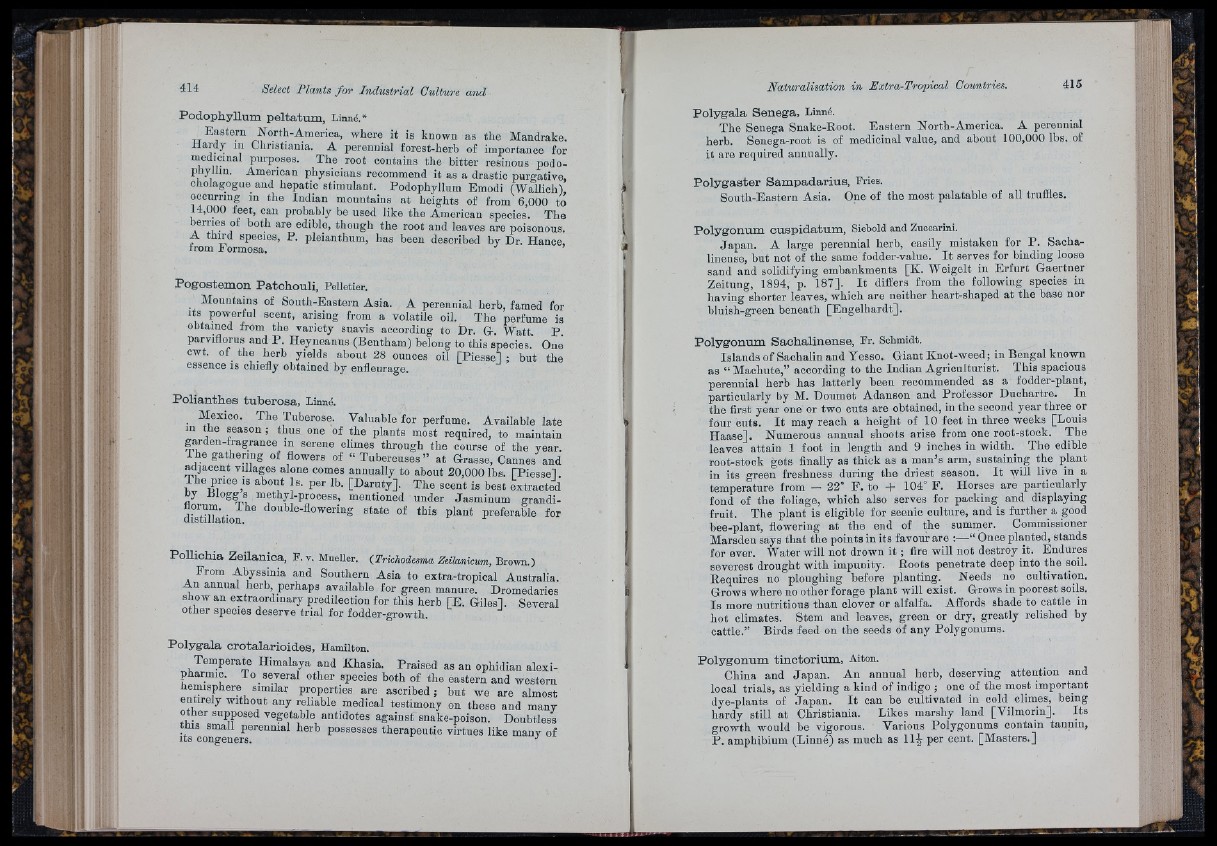
Podophyllum peltatum, Linné.*
Eastern North-America, where it is known as the Mandrake.
Hardy in Christiania. A perennial forest-herb of importance for
medicinal purposes. The root contains the bitter resinous podo-
phyllm. American physicians recommend it as a drastic purgative,
cholagogue and hepatic stimulant. Podophyllum Emodi (Wallich),
occurring in the Indian mountains at heights of from 6,000 to
14,000 feet, can probably be used like the American species. The
berries of both are edible, though the root and leaves are poisonous.
A third species, P. pleianthum, has been described by Dr. Hance,
from Formosa. •’ ’
Pogostemon Patchouli, Pelletier.
Mountains of South-Eastern Asia. A perennial herb, famed for
Its powerful scent, arising from a volatile oil. The perfume is
obtained from the variety suavis according to Dr. G. Watt. P .
parviflorus and P. Heyneanus (Bentham) belong to this species. One
cwt. of the herb yields about 28 ounces oil [Piesse] ; but the
essence is chiefly obtained by enfleurage.
Polianthes tuberosa, Linné.
Mexico. The Tuberose. Valuable for perfume. Available late
m the season ; thus one of the plants most required, to maintain
garden-fragrance in serene climes through the course of the year.
The gathering of flowers of “ Tubereuses” a t Grasse, Cannes and
adjacent villages alone comes annually to about 20,000 lbs. [P ie sse !.
The price m about Is. per lb. [Daruty]. The seent is best extracted
by Blogg s methyl-process, mentioned under Jasminum grandi-
dT /tXtio n double-flowering state of this plant preferable for
PoUichia Zeilanica, F. v. Muelier. {Trichodesma Zeilanicum, Brown.)
From Abyssinia and Southern Asia to extra-tropical Australia.
An annual herb, perhaps available for green manure. Dromedaries
show an extraordinary predilection for this herb [E . Giles]. Several
other species deserve trial for fodder-growth.
Polygala crotalarioides, Hamiiton.
Teniperate Himalaya and Khasia. Praised as an ophidian alexi-
pharmic. To several other species both of the eastern and western
hemisphere similar properties are ascribed; but we are almost
entirely without any reliable medical testimony on these and many
other supposed vegetable antidotes against snake-poison. Doubtless
tnis small perennial herb possesses therapeutic virtues like many of
Its congeners.
415
P o ly g a la S e n e g a , Linné.
The Senega Snake-Root. Eastern North-America. A perennial
herb. Senega-root is of medicinal value, and about 100,000 lbs. of
it are required annually.
P o l y g a s t e r S am p a d a r iu s , Fries.
South-Eastern Asia. One of the most palatable of all truffles.
P o ly g o n u m c u s p id a tu m , Siebold and Zuccarini.
Jap an . A large perennial herb, easily mistaken for P. Sacha-
linense, but not of the same fodder-value. I t serves for binding loose
sand and solidifying embankments [K. Weigelt in Erfurt Gaertner
Zeitung, 1894, p. 187]. I t differs from the following species in
having shorter leaves, which are neither heart-shaped at the base nor
bluish-green beneath [Engelhardt].
P o ly g o n u m S a c h a lin e n s e , Fr. Schmidt.
Islands of Sachalin and Yesso. Giant Knot-weed; in Bengal known
as “ Machute,” according to the Indian Agriculturist. This spacious
perennial herb has latterly been recommended as a fodder-plant,
particularly by M. Doumet Adanson and Professor Duchartre. In
the first year one or two cuts are obtained, in the second year three or
four cuts. I t may reach a height of 10 feet in three weeks [Louis
Haase]. Numerous annual shoots arise from one root-stoek. The
leaves attain 1 foot iu length and 9 inches in width. The edible
root-stock gets finally as tbiek as a man’s arm, sustaining the plant
in its green freshness during the driest season. I t will live in a
temperature from — 22° F . to 104° F. Horses are particularly
fond of the foliage, which also serves for packing and displaying
fruit. The plant is eligible for scenic culture, and is further a good
bee-plant, flowering at the end of the summer. Commissioner
Marsden says th a t the points in its favour are :—“ Once planted, stands
for ever. Water will not drown it ; fire will not destroy it. Endures
severest drought with impunity. Roots penetrate deep into the soil.
Requires no ploughing before planting. Needs no cultivation.
Grows where no other forage plant will exist. Grows in poorest soils.
Is more nutritious than clover or alfalfa. Affords shade to cattle in
hot climates. Stem and leaves, green or dry, greatly relished by
cattle.” Birds feed ou the seeds of any Polygonums.
P o ly g o n u m t in c to r iu m , Aiton.
China and Jap an . An annual herb, deserving attention and
local trials, as yielding a kind of indigo ; one of the most important
dye-plauts of Japan. I t can be cultivated in cold climes, being
hardy still at Christiania. Likes marshy land [Vilmorin]. Its
growth would be vigorous. Various Polygonums contain tannin,
P . amphibium (Linné) as much as 11^ per cent. [Masters.]